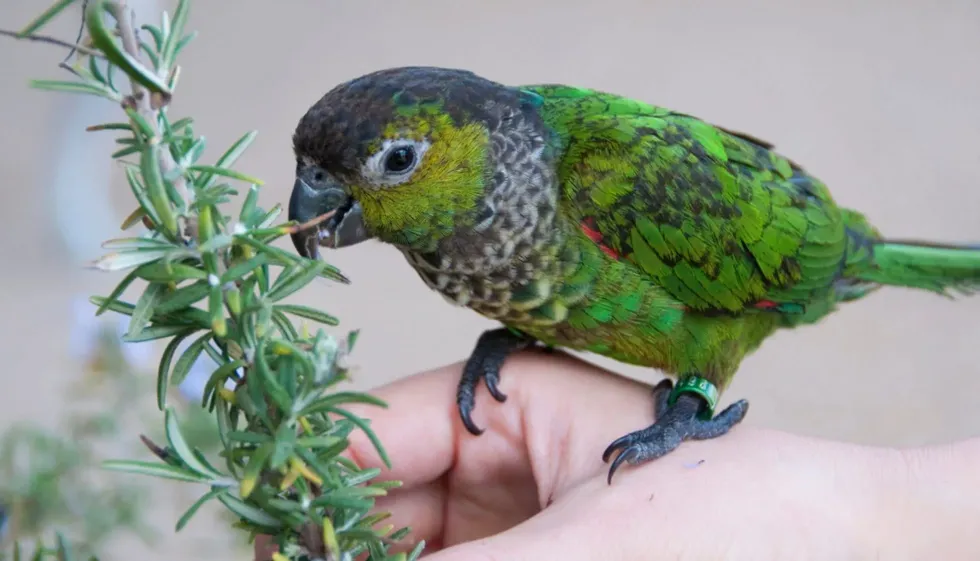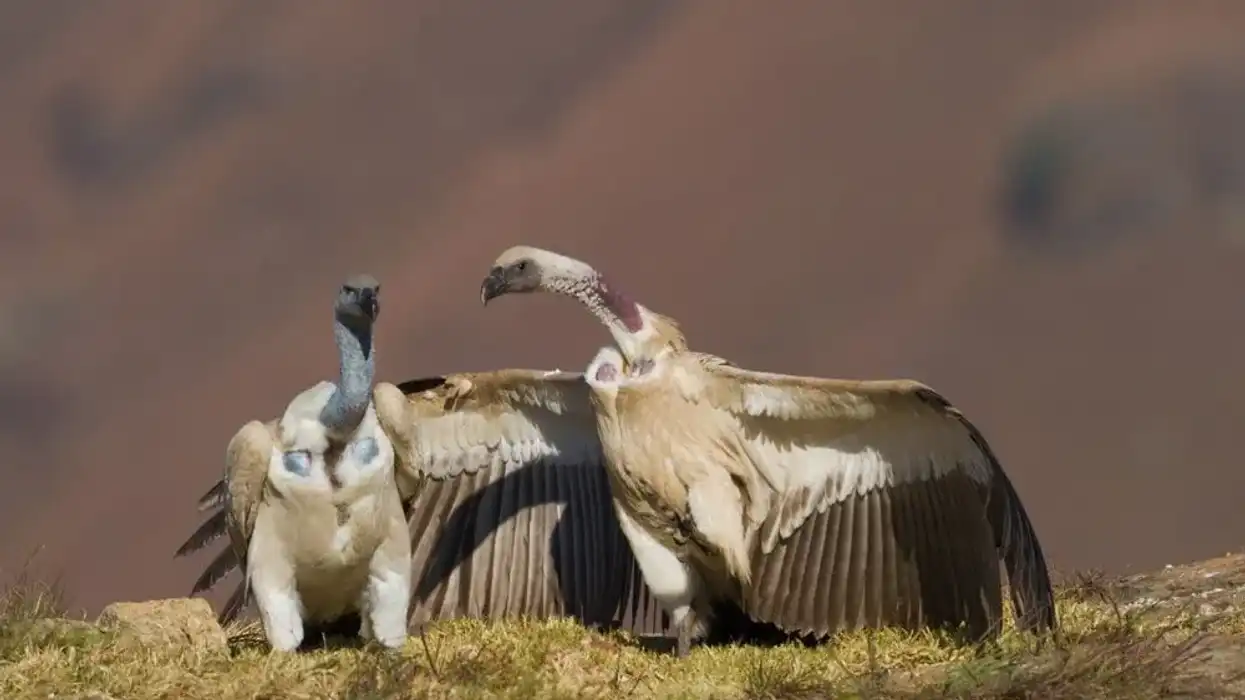If you are looking for a sweet, mild-mannered bird to compliment the liveliness of your household, then the black-capped conure is the perfect parrot for the job. They are a natural fit in any house, and their personality makes them perfect for a quiet life indoors.
So, the next time you visit a pet store, be sure to keep an eye out for these black-white darlings! They are naturally found in South America, in the grassy, humid forests of countries like Peru, Bolivia, and more.
They are also high fliers and are frequently found on heights as tall as 6000 ft (1828.8 m). That is taller than most mountains in the world!
They do, as their name suggests, look like they have a black cap on their heads, which is to say that they have a black shade towards their head. Their bodies remain largely mixed in with grays and whites, and they enjoy a sweet temperament that makes them a favorite for first-time pet owners.
They are also highly sociable and love to talk to people and animals alike
Do you want to know more about this friendly bird? Then read on! You can also check out other feathered friends with our articles on the swallow-tailed kite and the hyacinth macaw too!
Black-Capped Conure Interesting Facts
What type of animal is a black-capped conure?
The Pyrrhura rupicola is a type of parrot.
What class of animal does a black-capped conure belong to?
The black-capped parakeet belongs to a class of birds.
How many black-capped conures are there in the world?
Due to a lack of research, the population of this parrot is unknown.
Where does a black-capped conure live?
The black-capped conure is a South American bird that is native to Bolivia, Peru, and southwestern Brazil.
What is a black-capped conure's habitat?
The black-capped conure lives in the wetlands. It may be found in the humid forest from the Amazonian lowland up to the eastern Andes slopes at a height of about 6000 ft (1828.8 m).
Who do black-capped conures live with?
Black-capped parakeets are extremely social birds (from the family Psittacidae) and common roosters. They can form flocks of up to 30 birds in the wild. Little groups of families might be found throughout the breeding season. The call of these parrots is audible up to 3.2 km away and alerts other parrots of the pack if predators are approaching.
How long does a black-capped conure live?
The lifespan of the black-capped conure is varying from 10-15 years in the wild, depending on its environment. While in captivity, the average lifespan of these species is around 30 years. So, the lifespan of these pet birds mostly depends upon their surroundings.
How do they reproduce?
The breeding season for these birds is from months of February to March. Between the ages of one and three, these species reach sexual maturity. During the breeding season, they stay in small groups. A clutch usually consists of four to seven eggs. Mostly, they have a 24-day incubation phase before receiving parental care for seven to eight weeks.
What is their conservation status?
The conservation status of the black-capped conures (native to the Amazon basin and slopes in South American locations such as in Peru, and Bolivia, and other West Bolivian locations), is Near Threatened according to IUCN.
Black-Capped Conure Fun Facts
What do black-capped conures look like?
This bird has a dark brown with a black cap, reddish wing coverts (upper), a white-colored, scaly breast and neck, and a black-colored beak. Instead of the inverse, the breast hairs are dark shades with light tips. The primary coverts and wingtips of young birds are greener than those of adults.
How cute are they?
This rock conure pet species with bright green color, black cap and beak, calmness, and friendly nature definitely seem cute.
How do they communicate?
The black-capped conure personality isn't known for being a terrific communicator. The black-capped conure talking talent is pale in comparison to those of Kea parrots. That isn't to say that this bird can't be taught to speak and make vocalizations.
The black-capped can acquire just a few phrases and words with serious instruction and repetitive methods. Although, this bird is quite a calm species of the conure family and stays timid, and shows shy behavior most of the time. These species have inquisitive, playful, and affectionate personalities.
How big is a black-capped conure?
The average length of the rock conure or black-capped conures is 10 in (25.4 cm), while the length of the cherry-headed conure is 13 in (33.02 cm). Thus the length of the rock conure bird is much smaller than the cherry-headed conure bird.
How fast can a black-capped conure fly?
The natural flying speed of this parrot (Pyrrhura rupicola) is not available due to a lack of research.
How much does a black-capped conure weigh?
The species of conure bird is one of the smallest conures with an average of weight 2.5 oz (70.9 g).
What are the male and female names of the species?
Male and female parrots are not given any distinguished name.
What would you call a baby black-capped conure?
There is not any special name for a black-capped conure baby.
What do they eat?
A healthy diet of vegetables, fresh fruits, and pellets should be offered to clack-capped conures. The pellets should make up roughly 75% of the bird's diet.
Vegetables and fresh fruits should make up 25% of their diet. Nuts and seeds and other high-fat food should be used as a treat and to complement the diet in order to maintain excellent health.
A black-capped conure (family Psittacidae), like other pet birds, requires a variety of seeds. They can be fed a single seed or a mix of several.
All pitted fruits should be avoided, and seeds should be removed from the bird's food because they are detrimental to the bird's health.
For their fine health and to keep them from becoming bored with the same food, they should be fed a mix of fruits and veggies with a good pallet mix. It is a fact that in some areas, Mealy parrots are killed for food.
Are they poisonous?
The black-capped parakeet bird (genus Pyrrhura) is not poisonous.
Would they make a good pet?
These birds are quiet and shy, but they are also playful and chirpy. The black-capped conure species has won the hearts of several keepers thanks to its distinct appearance, bright patterning, and sociable, goofy personality.
Black-capped conure care is simple and it makes an excellent first pet. Furthermore, they are one of the calmer conure breeds with well-balanced characteristics. These small birds have a kind, docile, and frequently funny nature, which makes them ideal pet parrots.
Parrots and other pet birds in the wild travel hundreds of miles a day, seek food, and engage in a variety of other survival-related behavior, all of which provide them with intensive physical exercise.
Bird owners must do all possible to maximize their pets' opportunities to roam around the cage and exercise (play or chasing) more, as keeping them in captivity (in a cage) unwittingly reduces their ability to provide them with appropriate exercise to sustain their physical conditions.
Playing with a fun toy outside the cage with a pet bird helps encourage good exercise habits. Ensure your bird gets out of the cage for regulated playtime each day to provide it an additional opportunity for exercise.
Talking, singing, or whistling type of behavior are all indications that your pet conure is happy, healthy, and satisfied. These parrots aren't known for their capacity to speak, although they can learn a few dozen words.
Did you know...
If this shy bird (native to Peru, Brazil, and Bolivia) is restless, it may pluck its feathers. Replace or add engaging items to the cage and extend the time the black-capped conure is out to stop plucking.
There are two subspecies of this bird. The first is Pyrrhura rupicola rupicola, which is found in Peru and western South America. The second subspecies is Pyrrhura rupicola sandiae, also known as the Sandia conure among breeders and pet owners. South-eastern Peru, Northern Bolivia, and western Brazil are home to these Sandia conure Sandiae birds.
Besides the two subspecies, black-capped conures have been observed in the wild breeding with green-cheeked conures. Black-capped conures require unlimited access to water that is clean, fresh, and free of any hazardous minerals or salts. It keeps the parrot (genus Pyrrhura) hydrated at all times.
A black-capped conure price is normally between $450-$500. The golden conure species is one of the rarest conures bird in the wild.
Both the sun and the green-cheeked conures are clamoring for your attention because these conures are even more inclined to be family birds rather than single-person birds. This is a good characteristic in many contexts. Conure parrots have 'big bird' attitudes and qualities despite their diminutive size.
How do you tell the difference between a male and female black-capped conure?
Males and females have the same coloration. DNA testing or a surgical sexing operation are the only ways to tell the sexes differently. The yellow-sided black-capped conure is a mutant of this species with yellow coloring on the sides of the neck and head.
How do you identify a black-capped conure?
The black-capped conure species is a green bird with a brownish-black cap and a white scale patterning on the neck and breast. The top wing coverts have a hint of red color at the leading edge. The green abdomen has bluish markings, and the undersides of the tail feathers are dark gray.
Here at Kidadl, we have carefully created lots of interesting family-friendly animal facts for everyone to discover! Learn more about some other birds from our Palm Warbler fun facts and Amazon Parrot facts pages.
You can even occupy yourself at home by coloring in one of our free printable golden conure coloring pages.










